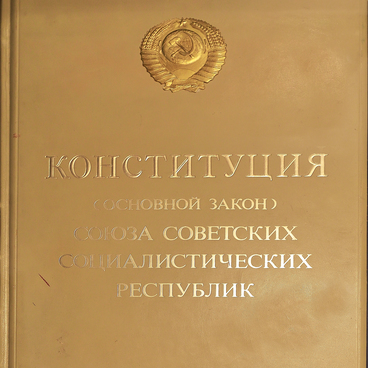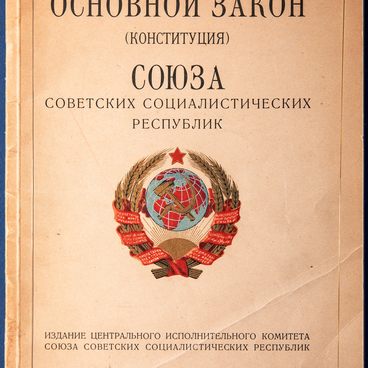In 1934, the 17th Congress of the Russian Communist Party of the Bolsheviks proclaimed that socialism had been mainly established in the USSR. Due to this, the decree of the 7th Extraordinary All-Russia Congress of Soviets approved of the new Constitution of the USSR on December 5, 1936.
For the first time it fixated the separation of power bodies into legislative and executive. The two-chamber Supreme Council (Soviet) became the supreme legislative power in the country, and in between the sessions, its Presidium was to perform those functions. The supreme executive authority was entrusted to the Council of Peopleʼs Commissars.
Also for the first time ever, the Constitution of 1936 established the leading place of the Communist party in the political system of the Soviet society. As the political basis of the USSR, it called the Soviets of deputies from working people, as the economic one – the socialist system of economy and socialist ownership of instruments and means of production. The Constitution envisaged two forms of socialist property, i.e. the state one (‘the weal of the whole people’) and the collective farm – cooperative one.
The new fundamental law renamed the Soviets of deputies from workers, farmers, and Red Army servicemen into the Soviets of deputies from working people. This change was symbolic as it showed that over the years of the Soviet power the people had become the integrated whole.
The Constitution proclaimed that the socialist type of social relations had triumphed in the USSR, and such foundations of socialism as dominance of socialist property and co-existence of friendly classes, i.e. workers, farmers and people’s intellectual class, had emerged. Also the exploiting classes had been eliminated in the country.
According to the Constitution, each citizen of the USSR had one vote, could participate in elections on equal grounds. Women enjoyed the right to elect and be elected on an equal basis with men.
The new constitution declared the basic rights and freedoms of Soviet citizens, i.e. the right to work and to rest, to have free education, material support after retirement and in case of illness; freedom of speech, press, assembly, personal integrity.
Based on the Constitution of the Union, the Constitution of the Russian Soviet Federated Socialistic Republic was developed and then approved of by the 17th Extraordinary All-Russia Congress of Soviets on January 21, 1937.
For the first time it fixated the separation of power bodies into legislative and executive. The two-chamber Supreme Council (Soviet) became the supreme legislative power in the country, and in between the sessions, its Presidium was to perform those functions. The supreme executive authority was entrusted to the Council of Peopleʼs Commissars.
Also for the first time ever, the Constitution of 1936 established the leading place of the Communist party in the political system of the Soviet society. As the political basis of the USSR, it called the Soviets of deputies from working people, as the economic one – the socialist system of economy and socialist ownership of instruments and means of production. The Constitution envisaged two forms of socialist property, i.e. the state one (‘the weal of the whole people’) and the collective farm – cooperative one.
The new fundamental law renamed the Soviets of deputies from workers, farmers, and Red Army servicemen into the Soviets of deputies from working people. This change was symbolic as it showed that over the years of the Soviet power the people had become the integrated whole.
The Constitution proclaimed that the socialist type of social relations had triumphed in the USSR, and such foundations of socialism as dominance of socialist property and co-existence of friendly classes, i.e. workers, farmers and people’s intellectual class, had emerged. Also the exploiting classes had been eliminated in the country.
According to the Constitution, each citizen of the USSR had one vote, could participate in elections on equal grounds. Women enjoyed the right to elect and be elected on an equal basis with men.
The new constitution declared the basic rights and freedoms of Soviet citizens, i.e. the right to work and to rest, to have free education, material support after retirement and in case of illness; freedom of speech, press, assembly, personal integrity.
Based on the Constitution of the Union, the Constitution of the Russian Soviet Federated Socialistic Republic was developed and then approved of by the 17th Extraordinary All-Russia Congress of Soviets on January 21, 1937.



